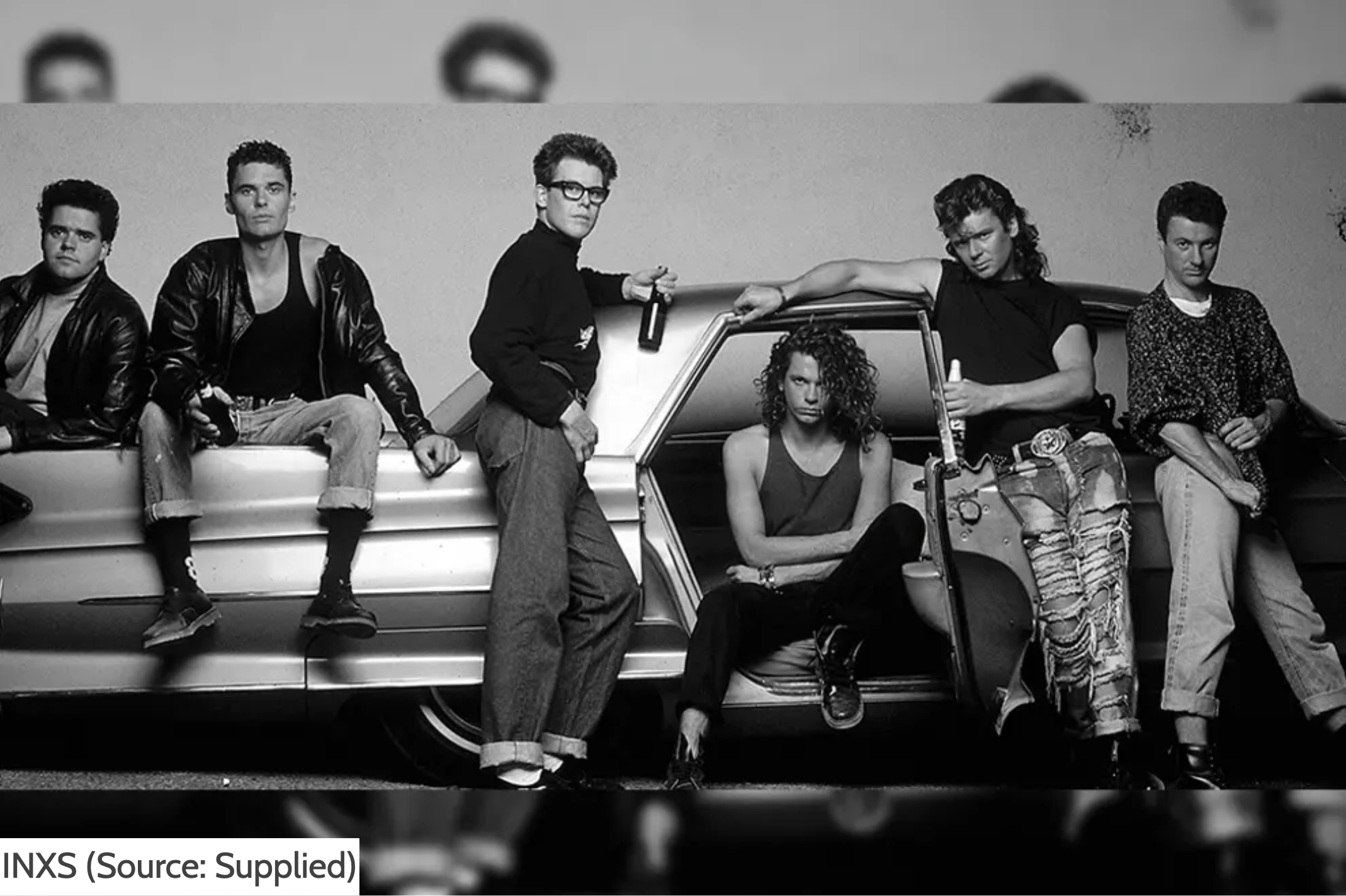40 Years Of ‘The Swing’: How INXS Channelled Equality & Laid The Blueprint For World Domination
‘The Swing’ was an unmitigated success for INXS. While it topped the Australian charts, it also prompted sold-out tours to a rapidly broadening demographic in terms of both age and musical tastes.

INXS (Source: Supplied)
In early April 1984—right on 40 years ago—Oz rock legends INXS hit the top of the Australian album charts for the first time with their fourth record, The Swing, just two months after they’d scored their first homeland #1 single with the album’s lead track, Original Sin.
It was the culmination of many years of hard work on the thriving Australian pub scene and built perfectly on the strong foundations set by its predecessor, Shabooh Shoobah (1982). Their third album had risen to #5 on the Australian chart and spawned Top 20 hits in Don’t Change and The One Thing, the latter of which enjoyed considerable radio and chart success in that toughest of markets, America.
But the band were at something of an impasse, caught between appealing to hardened Australian rock crowds and cultivating a more global appeal. To gain traction in foreign markets, they needed to boost the band’s quotient of funk, swagger and sexuality; traits often pilloried on the sweaty and unforgiving Aussie pub circuit.
But as it transpired, with The Swing, INXS honed their sound into a perfect (for the time) fusion of new wave, rock, and dance, which—combined with their inherent pop smarts—laid the blueprint for their eventual world domination while still maintaining their immense appeal at home.
Here’s how it went down.
THE SESSIONS
The road towards The Swing began in the sweetest possible way in 1983 while INXS were on the second leg of their extensive first US tour and had ventured north to Canada to open some shows for fellow Aussie hit-machines Men At Work.
A chance meeting backstage with legendary Chic guitarist and co-founder Nile Rodgers – who’d just come off a massive win producing David Bowie’s Let’s Dance opus, the singer’s highest-selling album – had unveiled something of a mutual admiration society, with the young Aussie rockers big fans of both Chic and Rodgers’ solo work and the funk legend having had his ears pricked by the dance-y undertones of The One Thing.
They got on so well that at the end of their ’83 US tour, before heading home, they went to New York and joined Rodgers at famed studio Power Station, transforming a song they had in their kitbag with the working title Brand New Day – penned by the now pivotal writing partnership of keyboardist Andrew Farriss and frontman Michael Hutchence – into the trailblazing Original Sin.
As well as teasing out a prominent dance edge for Original Sin, Rodgers would make two key moves that impacted the finished product: he convinced the band to change the chorus from “Dream on white boy/Dream on white girl” to “Dream on black boy/Dream on white girl” (claiming later that “psychologically it made a bigger statement”), and secondly, he roped in his friend Daryl Hall (of pop-rock juggernaut Hall & Oates) to provide the song’s signature backing vocals.
With the lead single in the can, for the rest of the album, the band decamped to Virgin Records’ The Manor Studios in Oxford, England, to work with rising UK producer Nick Launay, who’d already shown a strong affinity with Australian bands.
As Hutchence – who tragically passed away in 1997 – explained to Molly Meldrum in Richard Lowenstein’s documentary INXS: The Swing & Other Stories (1985):
“It was great because we were looking for a producer, and he was this little hotshot coming through—he did The Models and Midnight Oil, we loved all that stuff—and we thought, ‘Let’s go with this sounds guy.’ He was pulling sounds that we’d never heard before in our lives. It created a new dimension.”
The band played Original Sin to Launay, and instead of being daunted, the young producer—also a big fan of Rodgers and his work—stepped up to the plate as he oversaw the ambitious sessions. He matched the lead single’s dance factor and added notable touches such as orchestral flourishes and salsa rhythms to give INXS’ sonic evolution a distinct feel.
THE SONGS
In uDiscover Music’s 2023 piece The Swing: When INXS Felt The Funk And Embraced The Future, author Tim Peacock offered:
“Taken as a whole, the album proved that INXS were well on the way to alchemizing something unique from rock, funk, and the rapidly changing trends on the dancefloor.
“The mammoth beats and monster grooves that provided the foundation for tracks such as Love Is (What I Say) and Melting In The Sun showed that Jon Farriss and Garry Gary Beers had become a formidable rhythm section, while the infectious melodies and killer choruses driving Burn For You, Dancing On The Jetty and the electro-tinged I Send A Message proved beyond reasonable doubt that Hutchence and Andrew Farriss were fast developing into one of contemporary pop’s most accomplished songwriting teams.”
Though Original Sin had set the bar high, The Swing’s subsequent singles also acquitted themselves extremely well.
The upbeat and optimistic I Send A Message went to #3 in Australia, the horn-laden track dripping with confidence and bravado and described by Cash Box as “a powerful dance cut” with a “frenetic backbeat” and “staccato vocal”.
Follow-up Burn For You also peaked at #3, the more romantic pop number riding atop an infectious beat and augmented by a memorable Richard Lowenstein film clip – the first of 15 he would conjure for INXS – which was largely shot up in Far-North Queensland.
The album’s final single, Dancing On The Jetty, fared less well commercially, stalling at #39 (although it’s always tough for a fourth single when most fans own the album by the time it’s released). The song harks back to the tougher INXS sound of their early years, featuring a powerhouse Hutchence vocal and Launay production quite reminiscent of his recent work helming Midnight Oil’s 1982 opus 10,9,8,7,6,5,4,3,2,1.
And it wasn’t just the singles that hit home; The Swing ran deep with powerful album cuts such as Melting In The Sun, Love Is (What I Say) and All The Voices. But for many fans (this scribe included), it’s the Andrew Farriss composition Johnson’s Aeroplane that steals the show, the vaguely ominous but ludicrously catchy slow burn banger one of the highlights of INXS’ overall non-singles repertoire.
THE SUCCESS
The Swing was an unmitigated success for INXS. As well as topping the Australian charts, it prompted sold-out tours to hordes of ravenous fans from a rapidly broadening demographic in terms of both age and musical tastes.
These tours extended not only through the length and breadth of Australia but also through Europe, the UK and North America: it would still take a few years for the ultimate payoff in these markets, but the seeds were well and truly sown.
By the end of 1984, The Swing had gone double platinum at home, making it at the time one of the five biggest domestic albums in the history of Australian music. In 1985, they took home seven trophies at the 1984 Countdown Awards (the precursor to the ARIAs), performing Burn For You clad in the peak-Aussie attire of Akubras and Drizabones.
From a critical perspective, the near-universal esteem in which The Swing was held has only magnified with time; the album now widely afforded its well-deserved status as a classic Aussie album.
In the 2010 book, The 100 Best Australian Albums (O’Donnell, Creswell and Mathieson), The Swing is ranked #56 with the authors offering:
“The post-punk affectations and new romantic plumage were fading away, revealing a rock band with funk leanings and pop instincts. The Swing is where it all came together…
“Unlike English bands of the era, the sparseness in INXS’ sound never became icy or antiseptic. There was an intrinsic warmth to the recordings that reached its zenith on the penultimate cut, Burn For You. Pointing towards their first blockbuster, the following year’s Listen Like Thieves, it marries a precocious keyboard part to R&B chord changes and panoramic strings. But no element overwhelms the others and the song’s chorus sweeps them all up into a soaring peak that reinforces the music’s ease.
“Equality: that was to be the enduring lesson of The Swing.”
This message of band unity was echoed in Rolling Stone’s 2020 piece 200 Greatest Australian Albums Of All Time, with The Swing ranked at #32 and author Lars Brandle also focussing on solidarity within the band’s ranks that was helping them take things to another level as a collective. He offered:
“This is no ordinary rock record. The attention to detail is outstanding. Everyone plays their part.
“The Swing is democracy in motion. There were no bystanders, no spare wheels on this machine.”
It wasn’t just the sonic shift towards more palatable musical waters that accounted for The Swing’s success. The songwriting had improved exponentially – now featuring more memorable hooks and more ambitious arrangements – as had their collective musicality, the band tighter than ever and all rowing resolutely in the same direction.
In a Michael Hutchence tribute piece titled Tightrope Walker, author Toby Creswell recounts Hutchence telling him in 1985 about the then-recent INXS success:
“Andrew and I might write most of the songs, but this is a real band. It’s not two writers and four dumb musicians.”
INXS were still in transition – not quite the finished product – and their amalgam of rock, pop and funk would continue to be refined and evolve. But would that all-important band unity, mateship, and camaraderie that made their fourth album so special be able to be sustained among the perils of fame and fortune that lay ahead?
Looking back now, it seems that The Swing found INXS in the sweet spot of success, not yet one of the biggest bands in the world but well on the way and still enjoying – as a team – that long road to the top.

